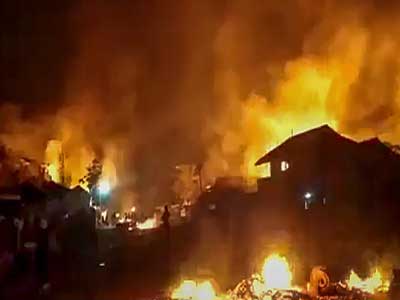Date : 26/06/2023
Relevance – GS Paper 3 – Internal Security – Insurgencies in North East
Key Words: Communal clash, Kukis, Meiteis, media debates, political posturing, unity, peace, interlink, mutual welfare, geographical destinies,
Context
The ongoing communal clash between Manipur's major communities, the Kukis and Meiteis, highlights the futility of media debates and political posturing in resolving deadly conflicts. The state remains tense after nearly two months, with a significant loss of lives and a large number of displaced people.
About Kuki tribe-
- The Kukis are an ethnic group including multiple tribes originally inhabiting the North-Eastern states of India such as Manipur, Mizoram and Assam; parts of Burma (now Myanmar), and Sylhet district and Chittagong hill tracts of Bangladesh.
- It is believed that Kuki people are native to the Mizo Hills (formerly Lushai), a mountainous region in the southeastern part of Mizoram in India.
- The Chin people of Myanmar and the Mizo people of Mizoram are kindred tribes of the Kukis. Collectively, they are termed the Zo people.
- While Kuki is not a term coined by the ethnic group itself, the tribes associated with it came to be generically called Kuki under colonial rule.
- In Manipur, the various Kuki tribes, living mainly in the hills, currently make up 30% of the total 28.5 lakh population of the State.
- The rest of the population of Manipur is made up mainly of two other ethnic groups — the Meiteis or non-tribal, Vaishnavite Hindus who live in the valley region of Manipur, and the Naga tribes, historically at loggerheads with the Kukis, also living in the hilly areas of the State.
- Of the 60 seats in the Manipur Assembly, 40 are held by Meiteis and the rest 20 seats are held by Kukis and Nagas.
- Some of the other important tribes of Manipur are Aimol, Anal, Chiru, Chothe etc.
About Meitei Community:
- The Meitei people, also known as the Manipuri people, are the predominant ethnic group of Manipur State.
- They speak the Meitei language (officially called Manipuri), one of the 22 official languages of India and the sole official language of Manipur State.
- Distribution:
- The Meiteis primarily settled in the Imphal Valley region in modern-day Manipur, though a sizable population has settled in the other Indian states of Assam, Tripura, Nagaland, Meghalaya, and Mizoram.
- There is also a notable presence of Meitei in the neighboring countries of Myanmar and Bangladesh.
- The Meitei ethnic group represents about 53% of Manipur's population.
- Clans: They are divided into clans, the members of which do not intermarry.
- Economy: Rice cultivation on irrigated fields is the basis of their economy.
- Religion: A majority follow Hinduism, while more than 8% are Muslims.
Interlink in Mutual Welfare:
Shared geographical destinies have shown how actions of one community impact others, emphasizing the need for consensus. Manipur's hills and valleys are interdependent for mutual welfare, and the valley's vulnerability stems from its topographical and agricultural advantages.
Acknowledge Meitei Pain:
While the present crisis in Manipur garners attention, the silent ethnic cleansing of Meiteis from the hills over decades should not be overlooked. The demand for Scheduled Tribe (ST) status represents a desperate cry against their confinement and humiliation.
Meiteis' Violent Response:
The violent response by Meiteis on May 3 in Churachandpur district, triggered by arson attacks by Kuki mobs, was fueled by a sense of immediate threat and an accumulation of grievances. This unleashed a surge of indiscriminate violence, targeting various institutions and individuals.
Role of Organizations:
While organizations like Arambai Tenggol and Meitei Leepun may have played a part, they are not solely responsible for the crisis. The situation reflects the eruption of primal instincts within Meitei society, overpowering rationality and causing widespread mobilization towards violence.
The Kukis' Plight:
The Kukis have suffered from unjust treatment, including humiliations and persecution due to government policies. This explains why they reacted with extreme violence during the rally, alongside the Meiteis.
Prioritizing Normalcy:
Finger-pointing and blame games are unproductive at this stage. The leadership must take the initiative to restore normalcy. Assam Rifles should provide conclusive evidence of Kuki militants returning to designated camps, facilitating the recovery of looted weapons. Emulating Mahatma Gandhi's decision to call off the Non-Cooperation Movement in the face of violence is a worthy example.
Conclusion:
Manipur's tragic conflict necessitates an end to posturing and a collective effort to find consensus and implement administrative changes for the benefit of all stakeholders. Acknowledging the pain of both communities, addressing grievances, and prioritizing peace are essential steps towards a harmonious future.
Probable Questions for Mains Examination
- Discuss the interlink between geographical destinies and communal conflicts, with specific reference to the ongoing clash between the Kukis and Meiteis in Manipur. Highlight the significance of consensus-building and mutual welfare in resolving such conflicts. (10 Marks, 150 Words)
- Analyzing the current situation in Manipur, critically examine the factors contributing to the violent response of the Meitei community and the plight of the Kukis. Discuss the role of leadership and the need for proactive measures to restore normalcy, address grievances, and ensure lasting peace in the region. (15 Marks, 250 Words)
Source – The Hindu








